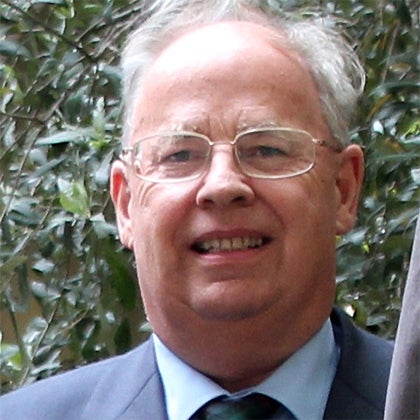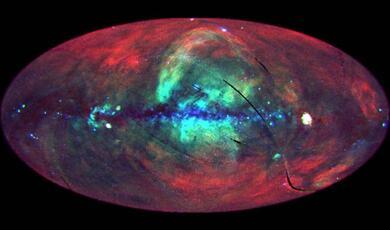The Search for Extra-Terrestrial Intelligence in the New Millennium
Share
- Details
- Text
- Audio
- Downloads
- Extra Reading
The lecture will describe our attempts to detect the presence of other advanced civilisations, explain why we should not be too disheartened by our failure so far and how a giant radio telescope, due for completion in 2020, would give us a realistic chance of searching the whole Galaxy.
Download Text
THE SEARCH FOR EXTRA-TERRESTRIAL INTELLIGENCE
IN THE NEW MILLENNIUM
Professor Ian Morison
SETI, the Search for Extra-terrestrial Intelligence, has now been actively pursued for close on 50 years without success. However this does not imply that we are alone in the Milky Way galaxy for, although most astronomers now agree that intelligent civilisations are far less common than once thought, we cannot say that there are none. But it does mean that they are likely to be at greater distances from us and, as yet, we have only seriously searched a tiny region of our galaxy. It will not be until the 2020's that an instrument, now on the drawing board, will give us the capability to detect radio signals of realistic power from across the whole galaxy. It is also possible that light, rather than radio, might be the communication carrier chosen by an alien race, but optical-SETI searches seeking out pulsed laser signals have only just begun.
The story so far
The subject may well have been inspired by the building of the 76m Mk1 radio telescope at Jodrell Bank in 1957. In 1959 two American astronomers, Guccione and Morrison, submitted a paper to the journal Nature in which they pointed out that, given two radio telescopes of comparable size to the Mk 1, it would be possible to communicate across interstellar distances by radio. They suggested a number of possible nearby, sun-like, stars that could be observed to see if any signals might be detected. This list included Tau Ceti and Epsilon Eridani, both about 12 light years distant. They also pointed out that the radio spectral lines of H and OH, whose frequencies would be known to all civilisations capable of communicating with us, lie in a very quiet part the radio spectrum and could act as markers at either end of a band of frequencies that might be used for interstellar communication. This band of frequencies has become known as the 'water hole' (H +OH = H20).
The following year Frank Drake, the father of SETI, using a 25m telescope at Green Bank, West Virginia, spent 6 hours every day for 2 months observing Tau Ceti and Epsilon Eridani in what was called Project Ozma - after L. Frank Baum's imaginary land of Oz. They did detect two brief signals in what should be a protected band for radio astronomy but it is thought that these were transmitted by the top secret, U2 spy-plane!
Frank Drake with the 25m telescope at Green Bank where he carried Project Ozma
The "WOW!" Signal
Since then there have been nearly 100 serious SETI searches. In 1977 a telescope called 'Big Ear' operated by Ohio State University, which had been carrying out an all-sky SETI survey since 1974, picked up a signal that appeared to have all the right characteristics. It is called the 'Wow' signal as the astronomer analysing the data wrote the word in the margin of the computer printout. Sadly, in follow-up observations, no signal has ever been picked up from the same region of sky.
The Big-Ear Telescope and the "WOW!" signal received in 1977
To make a radio message as easy as possible to detect over interstellar distances it would almost certainly be in the form of a very slow 'morse-code' type signal with a band width of a Hz or less - in contrast to an audio transmission requiring a bandwidth of several KHz. To detect such signals requires highly specialised receivers with millions of channels covering the band of frequencies being searched. Paul Horowitz at Harvard, a leader in this field, developed receivers to simultaneously analyze 80 million channels each with a bandwidth of 0.5 Hz. These were used to search the whole of the 'water hole' using the 25m Harvard/Smithsonian telescope at Oak Ridge in projects META and BETA.
Projects SERENDIP and Phoenix
Two significant searches have used the 305m Arecibo Telescope in Puerto Rico. The first of these, Project SERENDIP, still continues whilst the second, Project Phoenix, terminated in 2003. SERENDIP, under the auspices of the University of California, Berkeley, is using the Arecibo dish in 'piggy-back' mode with a dedicated feed system observing the sky close to wherever other astronomers are pointing the telescope. Though they have no control over what part of the sky is being observed, over a few years most of the sky accessible to the telescope will be observed, much of it several times over. SERENDIP is thus looking for signals that are seen on more than one occasion from the same location in the sky. A small part of this data, relating to a narrow band of radio frequencies close the 1400 MHz Hydrogen Line, is being analysed by home computers across the world in what is known as SETI@home. After a few years a number of signals with appropriate characteristics had been detected several times and a special observing session was set up to observe these in detail. However no signals appeared in the data to confirm a real detection.
This does highlight a real problem; a signal from ET might be transitory and one really needs to make an immediate confirmation that any signal has an extra-terrestrial origin. This was the premise of Project Phoenix that arose out of the NASA SETI project when the American Congress cut funding. This had been managed for NASA by the SETI Institute who then raised private funds to continue the targeted search part of the NASA programme and observe around 800 nearby sun-like stars. In project Phoenix, two telescopes were used to make simultaneous observations so that any signals originating within our solar system could be eliminated and there would be an immediate confirmation of any extra-terrestrial signal. Initially pairs of telescopes in Australia and the USA were used, but when the Arecibo telescope came back on-line after a major upgrade, it was used in parallel with the University of Manchester's 76m Lovell Telescope (formally Mk1) at Jodrell Bank.
The Arecibo Telescope used for the SETI@home observations and Project Phoenix
Due to their separation across the Atlantic any local interference at either telescope could be immediately discounted. In addition, as a result of the rotation of the Earth and the change in received frequency introduced by the Doppler effect, a signal from beyond our solar system would be received at Jodrell Bank at a precisely calculable frequency which is approximately 2 KHz lower in frequency than that received at Arecibo. Thus, when Arecibo detected a possible alien signal, the receiver at Jodrell, offset in frequency by the required amount, attempted to confirm the signal. This enabled the elimination of any signals received from Earth itself or satellites orbiting nearby in the Solar System. The system was proven each day by observing the very weak signal from the Pioneer 10 spacecraft, then more than 10 million km from Earth and far beyond Pluto! It hardly need saying that no positive signals were detected.
The Drake Equation
The lack of success prompts one to ask what the likelihood is that other advanced civilisations exist in the galaxy who would be attempting to contact us. If we do not expect there to be any other civilisations then there would not be a lot of point in searching. This problem was first addressed by an eminent group of scientists at a meeting organised by Frank Drake at Green Bank in 1961. As an agenda for the meeting he came up with an equation which attempts to estimate the number of civilisations within our galaxy who might be attempting to communicate with us. Known as the 'Drake Equation', it has two parts. The first part attempts to calculate how often intelligent civilisations arise in the galaxy and the second is simply the period of time that such a civilisation might attempt to communicate with us once it has arisen.
A plaque at Green Bank Observatory commemorating the Drake Equation
Some of the factors in the equation are reasonably well known; such as the number of stars born each year in the galaxy, the percentage of these stars (like our Sun) that are hot enough, but also live long enough, to allow intelligent life to arise and the percentage of these that have solar systems. But others are far harder to estimate. For example, given a planet with a suitable environment it seems likely that simple life will arise - it happened here on Earth virtually as soon as the Earth could sustain life. But it then took several billion years for multi-cellular life to arise and finally evolve into an intelligent species. So it appears that a planet must retain an equable climate for a very long period of time. The conditions that allow this to happen on a planet may not occur very often. Our Earth has a large Moon which stabilises its rotation axis, its surface is recycled due to plate tectonics and this releases Carbon Dioxide, bound up into carbonates, back into the atmosphere. This recycling has helped keep the Earth warm enough for liquid water to remain on the surface and hence allow life to flourish. Jupiter's presence in our Solar system has reduced the number of comets hitting the Earth; such impacts have given the Earth much of its water but too high an impact rate might well impede the evolution of an intelligent species. It could well be, as some have written, a 'Rare Earth'. How many might there be amongst the stars?
It was widely assumed that once multi-cellular life had formed, evolution would drive life towards intelligence, but this tenant had been challenged in recent years - a very well adapted, but not intelligent, species could perhaps remain dominant for considerable periods of time preventing the emergence of an intelligent species.
The final factor in this part of the equation is the percentage of those civilisations capable of communicating with us who would actually choose to do so. Our civilisation could, but currently does not, attempt to communicate. Indeed there are some who think that it would be unwise to make others aware that here on Earth we have a nice piece of interstellar real estate! Any attempts at communication are very long term with the round travel time for a two way conversations stretching into hundreds or thousands of years. It would be hard at present to obtain funding for such a programme. Estimates of 10% to 20% are often cited for this factor. This may well be optimistic.
The topic of 'leakage' radiation from, for example, radars and TV transmitters is often mentioned as a way of detecting advanced civilisations who do not choose to communicate with us. But this is, in this author's view, unlikely. Any signals that could be unintentionally detected over interstellar distances are, by definition, wasteful of energy. Already, on Earth, high power TV transmitters are being replaced with low power digital transmissions, satellites transmissions are very low power and fibre networks do not radiate at all. The 'leakage' phase is probably a very short time in the life of a civilisation and one that we would be unlikely to catch. It could be that airport radars and even very high power radars for monitoring (their) 'near-Earth' asteroids might exist long term and give us some chance of detecting their presence but we should not count on it.
When all these factors are evaluated and combined the average time between the emergence of advanced civilisations in our galaxy is derived. If we find it hard to estimate to estimate how often intelligent civilisations arise it is equally hard to estimate the length of time, on average, such civilisations might attempt to communicate with us. In principle, given a stable population and power from nuclear fusion, an advanced civilisation could survive for a time measured in millions of years. Often a period of 1000 years is chosen for want of anything better. This length of time is critical in trying to estimate how many other civilisations might be currently present in our galaxy. If, for example, a civilisation arose once every 100,000 years - a not unreasonable estimate - but typically, civilisations only attempt to communicate for 1000 years it is unlikely that more than one will be present at any given time. If, however, on average, they remain in a communicating phase for 1 million years then we might expect that 9 other civilisations would be present in our galaxy now.
When the Drake Equation was first evaluated, the estimates of other civilisations were quite high; numbers in the 100,000's or even 1 million were quoted. Nowadays astronomers who try to evaluate the Drake Equation are far less optimistic. Many estimates are in the ten's to hundreds and there are a minority of astronomers who suspect that, at this moment in time, we might be the only advanced civilisation in our galaxy.
The truth is we just do not know. It was once said with great insight that 'the Drake Equation is a wonderful way of encapsulating a lot of ignorance in a small space'. Absolutely true, but an obvious consequence is that wecannot say that we are alone in the galaxy. SETI is our only hope of finding out.
Optical Seti
Stars are not strong emitters of radio waves, it is thus not difficult to generate a signal that can be detected at great distance in the presence of the radio noise produced by a star - specifically that at the centre of the solar system from which a signal was being transmitted. (This would also be in the beam of the radio telescope that was attempting to detect the signal.) When SETI was first mooted it was believed that, in the visible part of the spectrum, it would be impossible to outshine a star, but Charles Townes, who having invented the laser, immediately realised that a laser might be able to generate very high intensity pulses that could, for brief instants of time, easily outshine a star. Thus the basis of optical SETI was laid. Laser systems close to what are required are now being developed for 'Star-wars' type weapons and nuclear fusion power plants so we can easily envisage that advanced civilisation would have them.
Dan Werthimer and Geoff Marcy at the University of California, Berkeley and Paul Horowitz at Harvard University have been pioneers in O-SETI. The Berkeley pulsed laser search is directed by Dan Werthimer and plans to observe 2500 nearby, largely sun-like, stars, looking for very short bright pulses that might last a billionth of a second or so, transmitted by a powerful pulsed laser operated by a distant civilization. A second Berkeley search is for laser signals that are on for a large fraction of the time. This search, directed by Geoff Marcy, is a 1000 star program to search for ultra narrow band signals in the visible part of the spectrum (analogous to radio-SETI). They plan to search though thousands of extremely high resolution spectra for very sharp lines. Much of the data has already been take in an ongoing (and highly successful) planet search.
Horowitz's first detector system piggy-backed onto the Harvard University's 61 inch telescope whilst it was carrying out a survey of 2500 nearby sun-like stars. First light was in 0ctober 1998. The very sensitive detectors used to look for nanosecond time scale pulses are prone to false triggering so the light beam is split into two and both detectors have to detect an event for it to be significant. During the first 27 months of observations of the Harvard system two detections were made on average every three nights. The detection events appeared to be uncorrelated with stellar magnitude and did not exhibit any periodicity. In fact, there is was no clear evidence that they originated from light entering the telescope from the direction of the targeted star.
The Harvard group then combined their targeted search efforts with a group at Princeton to make simultaneous observations at two separated sites. By November 2003, 16,000 observations totalling 2,400 hours had been made but no pulses were detected simultaneously at the two site. (First having taken into account an appropriate time delay due to their separation.)
In 2003, the telescope at Harvard was decommissioned, and so the targeted search ceased. Since then, the group have planned and commissioned an all-sky survey using a custom-built 72 inch (1.8m) telescope that came into operation in April 2006. The telescope is equipped with an array of 1024 light sensors that observes an area of sky 0.2 degrees wide by 1.6 degrees high. The telescope is a transit instrument observing a given declination on the celestial sphere as it passes due south. During one (sidereal) day of observations a 360 degree round strip of sky, 1.6 degrees high, will thus be observed. The next night the altitude of the telescope will be adjusted to observe an adjacent strip so that after ~ 200 clear nights the whole of the sky visible at Princeton will have been observed and the survey repeated.
The 1.8-m Harvard "Optical SETI" Survey telescope
Could we find evidence of other civilisations in our immediate locality?
As light and radio waves travel at the fastest speed possible through space other possible means of contact have tended to be ignored. But if speed is not important, then the sending of spacecraft across the galaxy as a one way communication medium might be a sensible way of making contact - perhaps to give us the benefit of the knowledge of a highly advanced civilisation. Indeed four spacecraft, Pioneer 10 and 11 and Voyagers 1 and 2, which are now coasting through space beyond our solar system, carry messages from our civilisation which would tell any one who recovered them a little about ourselves, the star system that we inhabit and even (very cleverly) the time that the spacecraft left our Earth. Much like Arthur C. Clarke's lunar monolith in 2001: A Space Odyssey, it is just possible that an alien craft might have landed on the Moon (where it would not suffer the consequences of the erosion we have on Earth) waiting for us to discover it. Or perhaps an alien space craft might be discovered in solar orbit. Fanciful, but not impossible. It is also possible that evidence of a past extraterrestrial civilisation might be found without there being any intent on their part. We are now producing quite significant amounts of space debris. Particles less than about one micro-metre in size, perhaps of exotic alloys, will be ejected from our solar system by radiation pressure and could, far into the future, land on the surface of an airless moon. When our Sun reaches the end of its life, intense solar winds could even eject larger particles into the interstellar medium. Might we find such material from another civilisation below the surface of the dust making up the lunar regolith?
For these possibilities to be at all likely, many civilisations must have reached high technical competence in the distant past. If one such civilisation came into existence every 100,000 years then, in the period since have been sufficient heavier elements within the interstellar medium to allow planets to form and the intelligent life to have evolved - perhaps 4 billion years, 40,000 advanced civilisation might have come and gone. Could one of them have left any evidence of their existence?
The future of radio-SETI
It has been a long term dream of SETI astronomers to have a large dedicated telescope of their own. This dream is now being realised with the construction of the Allen Telescope Array (ATA) at Hat Creek in California. The ATA is a combined project of the SETI Institute and the Radio Astronomy Laboratory at the University of California, Berkeley to construct a Radio Telescope that will search for extra-terrestrial intelligence and simultaneously carry out astronomical research. This is, as one might suspect, not a telescope 'as we know it' and is exploiting the great advances in computing technology to build a highly flexible instrument where, as Jill Tarter of the SETI Institute points out, 'steel is being replaced by silicon'.
The cost of building a large single dish antenna tends to rise as the cube of the diameter. The equivalent area could, in principle, be made up of an array of smaller antennas, in which case the cost only rises as the square of the diameter. However the task of combining the signals from the individual elements must also be taken into account. With the reducing cost of electronics; from the receivers on each antenna, their fibre-optic links to the central processing system and the correlators that combine the data - this smallD/largeN approach has become both feasible and cost effective. But, in addition, there is a far more fundamental reason why this approach is particularly appropriate for SETI purposes. A large single antenna is only sensitive to signals received from a very small area of the sky called its 'beamwidth'. For a 120m antenna observing in the region of the 'water-hole' this would be of order 7-8 arc minutes. (The use of multi-beam receiver system can increase this by a small factor.) Let is suppose that, as in the ATA, the same effective area is made up by combining the signals from 350, 7x6 m antennas. These small antennas will have a beam width of ~ 120/7 times greater (beamwidth scales directly with diameter) giving ~ 146x125 arc minutes - over 2 degrees! At the heart of the array, the signals from all antennas are combined together to form a beam of comparable size to the single 120m antenna and having the same sensitivity. So nothing is lost. But there is much to gain. If, in additional electronics, the signals from each antenna are combined in a slightly different way then a second narrow beam can be formed anywhere within the overall beam of the small antennas as shown in the figure below. But if one can form a second beam, then with further electronics one can form a third, a fourth and so on. So the ATA will have multiple beams and could thus observe many stars simultaneously whilst the Berkley group could be observing pulsars or other astronomical objects in the same area of sky.
The multiple beams formed with the Allen Telescope Array
The first phase comprising 42 antennas was commissioned in the summer of 2007 and will start its SETI observations with a survey of the galactic centre.
Antennas of the Allen Telescope Array
In many respects the ATA is a technology demonstrator for what would be the ultimate radio-SETI instrument - at least for many decades. A major, 38M euros, European design study is now underway to finalise the technology for what is called the Square Kilometre Array (SKA). As its name implies, it aims to have a total collecting area of one square kilometre - a million square metres and the equivalent of ~90 x 120m single dishes in size. It would thus be nearly two orders of magnitude more sensitive than the ATA. Like the ATA it will also use the largeN/smallD approach, though the individual antennas might be somewhat larger, perhaps 12m in size. One hundred of these will be grouped close together to form the equivalent of a single 120m antenna to form what is called a station. Stations would then be located on a number of 'spiral arms' radiating from the centre of the array, their separation increasing away from the array centre. The overall size of the whole array could well be more than 3000 km so it will need to be located in a large, sparsely populated, area. A number of countries have offered to host the array in areas such as the plains of western Australia or the Northern Cape in South Africa.
The SKA will be a 17-country collaboration and require funding of ~ 1.5 Billion euros, so it is a truly major project. It is expected that the site will be selected in 2010 and the detailed design completed by 2012. Initial operation is expected in 2016 with final completion by 2020. Like the ATA it will have the ability to form multiple beams so whilst, for example, a search might being made for pulsars, beams could also be in use searching for any alien signals.
Should we be disheartened that no signals have as yet been detected? Not really, for as Peter Backus of the SET Institute has made clear, of the ~ 100 searches that have taken place since 1960, only SERENDIP and Phoenix (because of their use of the giant Arecibo Telescope) have had the sensitivity to detect signals from beyond our immediate locality in space. The use of the ATA will extend the search further out
An artists impression of the central core of the Square Kilometre Array
into the galaxy but we may well have to wait until the use of the SKA to have a realistic chance of detection if, as many astronomers now believe, intelligent life is thinly spread around the galaxy.
There can be no better way to end this transcript than by quoting from Cuccioni and Morrison's 1959 paper; 'the probability of success (in our search for extraterrestrial life) is difficult to estimate, but if we never search, the chance of success is zero.'
©Professor Ian Morison, Gresham College, 3 April 2008
This event was on Thu, 03 Apr 2008
Support Gresham
Gresham College has offered an outstanding education to the public free of charge for over 400 years. Today, Gresham College plays an important role in fostering a love of learning and a greater understanding of ourselves and the world around us. Your donation will help to widen our reach and to broaden our audience, allowing more people to benefit from a high-quality education from some of the brightest minds.


 Login
Login







